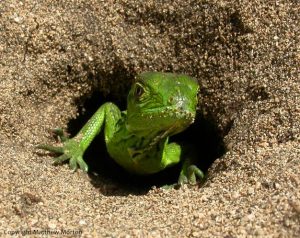Love ’em or hate ’em, those pesky, invasive iguanas are everywhere — and the population is growing exponentially.
 The Miami Herald reported the Florida Fish and Wildlife Conservation Commission this month hired a trapper for the first time to focus on managing the population on public land in the Keys. The FWC also started holding workshops on management efforts to show homeowners how to work traps, protect yards and ward off the reptiles.
The Miami Herald reported the Florida Fish and Wildlife Conservation Commission this month hired a trapper for the first time to focus on managing the population on public land in the Keys. The FWC also started holding workshops on management efforts to show homeowners how to work traps, protect yards and ward off the reptiles.
“We really want to empower people to know what they can do, how we can help folks help themselves,” Kristin Sommers, FWC’s exotic species coordinator, told the Herald. “FWC can’t go out and remove everybody’s iguanas. That’s just not possible.”
Sommers noted an increase in “human conflicts.” Iguanas have been damaging roads, showing up in shopping malls and are a common site on golf courses.
Iguanas on the Treasure Coast
It doesn’t take long to spot an iguana on the Treasure Coast.
“I’ve seen some fairly large ones basking,” Ken Gioeli, environmental agent at the St. Lucie County Cooperative Extension Service, said in an email. “They will eat many fruits and vegetables, and they could potentially spread salmonella in their droppings causing food poisoning.”
Gioeli suggests reporting any type of invasive species through ivegot1.org for early detecting and mapping of the critters.

Iguanas were first reported in Florida in the 1960s in Miami-Dade County, according to FWC’s website. There have been reports as far north as Alachua, Highlands, Hillsborough, Indian River and St. Lucie counties, the website says. Iguanas that far north are likely escaped or released pets and are unlikely to establish populations, as they are not cold-hardy.
Source: Invasive iguanas on the run from Florida Fish and Wildlife in South Florida
